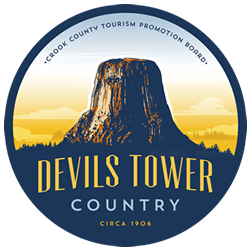Crook County is famous for being the location of the nation's first national monument, Devils Tower but there is so much more to see and do here in Devils Tower Country. Crook County has world class wildlife watching and wildlife photography opportunities. As a low population county in a low population state we have phenomenal wildlife habitat and a variety of wildlife species for you to spot. Elk, moose, mule deer, whitetail deer, wild turkey, prairie dog, bald eagle, black bear and sage grouse are just a few of the species present in the county.
We invite you to visit Crook County and see why we are one of the best wildlife watching destinations in the United States. Some of the best places to spot wildlife is in the county's state parks, national forests, wilderness areas and of course in and around Devils Tower National Monument.
Meet some of the local animal species you can spot while visiting Crook County. When viewing or photographing animals please use common sense guidelines. Don't feed or get too close to animals especially mothers and their young. Please use caution when traveling on highways and roads as wildlife are common along Wyoming's roadways.
The American Badger
Often seen hunting in prairie dog towns this nocturnal predator has a large body with short legs and a white and black striped face.
Bald Eagle
The Bald Eagle is the national emblem of the United States. They are known for their white-feathered heads and impressive wingspans. Look for them near water where they can often be seen fishing.
Bobcat
The bobcat is a medium-sized North American cat with a “bobbed” tail, round face and pointed ears. These elusive mammals can be found in dense shrub, river bottoms and forested areas.
Merriam's Wild Turkey
Turkeys travel in flocks and search on the ground for nuts, berries, insects, & snails. In spring, males gather in clearings to perform courtship displays. They puff up their body feathers, flare their tails into a fan, and strut while giving a gobbling call. At night, turkeys fly into trees to roost.
Mule Deer
Mule deer are Wyoming's most abundant deer weighing up to 250 pounds and characterized by large ears and a bounding gait. They can be found in brushy areas, forests and grasslands.
White-tailed Deer
White-tailed deer are common in Crook County and can often be spotted in tall grass. They are known for their distinctive tails that flair upwards when fleeing.
Elk
The majestic elk is the largest member of the deer family. Elk can be seen in Crook County in all seasons. They prefer high altitudes and mountainous area and can be seen foraging in meadows. Early mornings and early evenings are ideal times to spot an elk.
Red & Grey Fox
Both Red & Grey foxes can be found in Crook County although the Red fox is more common. These delightful predators prey on small animals and also feed on carrion, berries and plants.
Moose
Moose are large animals with big heads and long legs. Moose can be found among the willows and brush along streams and ponds. Moose tracks are large with a two-toed hoof that is about 6 inches long.
Mountain Bluebird
Mountain Bluebirds are lovely little birds common in Crook County. As their name implies males are sky-blue with a lighter belly. Females are mostly gray-brown with tinges of pale blue in the wings and tail.
Muskrat
The muskrat greatly resembles its larger cousin, the beaver. They have webbed hind feet for swimming and smaller front feet for digging. They can be found in areas with like wetlands, ponds, lakes and marshes.
Porcupine
Porcupines are one of the largest rodents in the United States. They have long quills on their head, back and tail. These nocturnal animals sleep in trees and can be found in trees, logs and on nightly foraging runs.
Prairie Dog
The delightful prairie dog lives in communities or "towns". You can also hear them "barking" a vocal communication system to warn others of predators in the area. You can find them in prairie ecosystems.
Pronghorn Antelope
Pronghorn also known as antelope can be seen in open fields along highways. They are speedy and can run up to 60 miles per hour making them the fastest land animal in North America!
Sage-Grouse
Like their name suggests Sage-Grouse can be found in areas of sagebrush. During the spring males perform elaborate strutting displays on patches of bare ground called leks.

